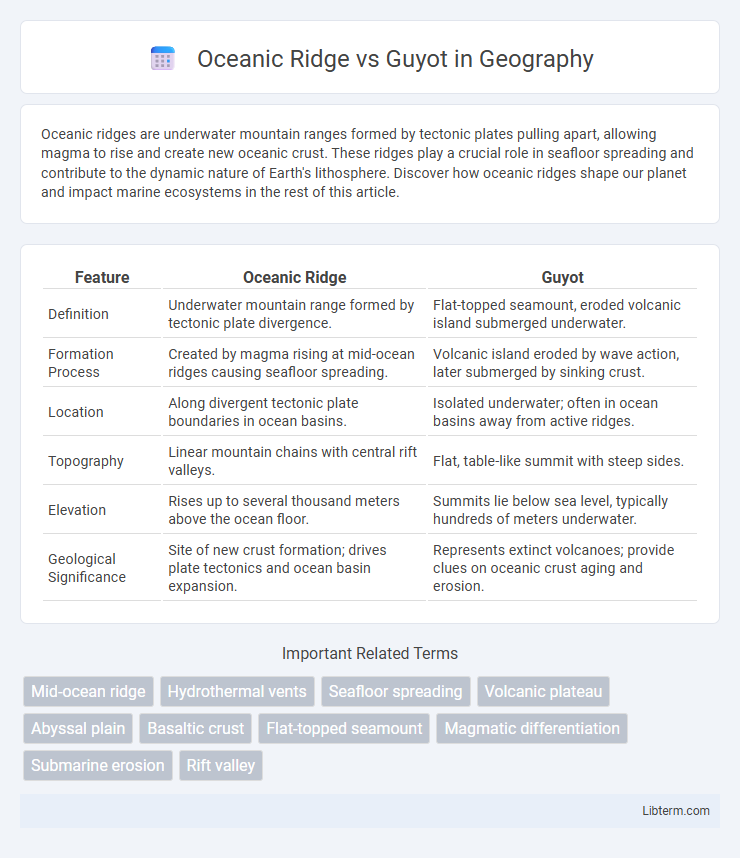Oceanic ridges are underwater mountain ranges formed by tectonic plates pulling apart, allowing magma to rise and create new oceanic crust. These ridges play a crucial role in seafloor spreading and contribute to the dynamic nature of Earth's lithosphere. Discover how oceanic ridges shape our planet and impact marine ecosystems in the rest of this article.
Table of Comparison
| Feature | Oceanic Ridge | Guyot |
|---|---|---|
| Definition | Underwater mountain range formed by tectonic plate divergence. | Flat-topped seamount, eroded volcanic island submerged underwater. |
| Formation Process | Created by magma rising at mid-ocean ridges causing seafloor spreading. | Volcanic island eroded by wave action, later submerged by sinking crust. |
| Location | Along divergent tectonic plate boundaries in ocean basins. | Isolated underwater; often in ocean basins away from active ridges. |
| Topography | Linear mountain chains with central rift valleys. | Flat, table-like summit with steep sides. |
| Elevation | Rises up to several thousand meters above the ocean floor. | Summits lie below sea level, typically hundreds of meters underwater. |
| Geological Significance | Site of new crust formation; drives plate tectonics and ocean basin expansion. | Represents extinct volcanoes; provide clues on oceanic crust aging and erosion. |
Introduction to Oceanic Ridge and Guyot
Oceanic ridges are underwater mountain ranges formed by tectonic plate divergence and volcanic activity, characterized by high heat flow and frequent earthquakes. Guyots, on the other hand, are flat-topped seamounts that represent extinct volcanoes eroded by wave action and submerged due to tectonic subsidence. Understanding these features provides insight into seafloor spreading processes and the geological history of ocean basins.
Definition of Oceanic Ridge
Oceanic Ridge refers to an extensive underwater mountain range formed by tectonic plate divergence and volcanic activity along mid-ocean ridges, characterized by continuous elevated topography on the seafloor. Guyots are flat-topped seamounts formed by volcanic islands that have subsided and been eroded below sea level. Unlike guyots, oceanic ridges are active volcanic regions and serve as key sites for seafloor spreading and hydrothermal vent ecosystems.
Definition of Guyot
A guyot is an isolated underwater volcanic mountain with a flat top, formed by erosion after the summit was once above sea level and later submerged. Oceanic ridges, in contrast, are extensive underwater mountain ranges created by tectonic plate divergence and volcanic activity along mid-ocean spreading centers. Guyots provide important geological records of sea level changes and plate movements, distinguishing them from the continuously active and elongated structures of oceanic ridges.
Formation Processes of Oceanic Ridges
Oceanic ridges form at divergent tectonic plate boundaries where magma rises from the mantle, creating new oceanic crust as the plates pull apart. This process involves continuous volcanic activity and seafloor spreading, leading to elevated underwater mountain chains such as the Mid-Atlantic Ridge. In contrast, guyots are flat-topped seamounts formed from eroded volcanic islands that have subsided below sea level, lacking the active magmatic processes found at oceanic ridges.
Formation Processes of Guyots
Guyots, also known as tablemounts, form through volcanic activity followed by subsidence and erosion; initially, a seamount rises above the ocean surface as an underwater volcano, then waves flatten its top over time. Unlike oceanic ridges, which are formed by divergent tectonic plate boundaries and continuous magma upwelling creating new oceanic crust, guyots result from isolated volcanic activity far from plate boundaries. Subsequent cooling, crustal subsidence, and coral reef growth contribute to the distinctive flat-topped shape of guyots beneath the sea surface.
Geological Features: Oceanic Ridge vs Guyot
Oceanic ridges are underwater mountain chains formed by tectonic plate divergence, characterized by continuous volcanic activity and a crestal rift valley. Guyots are flat-topped seamounts created by volcanic islands that have subsided and eroded, resulting in a distinctive plateau-like summit below sea level. These geological features highlight the dynamic volcanic processes and subsequent erosion shaping the ocean floor.
Locations and Distribution in the Oceans
Oceanic ridges are extensive underwater mountain chains primarily located along divergent tectonic plate boundaries, such as the Mid-Atlantic Ridge and the East Pacific Rise, stretching through all major oceans. Guyots, or flat-topped seamounts, are typically found in the Pacific Ocean, particularly in the central and western regions, where they are remnants of extinct volcanoes that have subsided below sea level. The global distribution of oceanic ridges forms continuous submarine mountain belts, while guyots are scattered features primarily associated with hotspot volcanic activity and seafloor subsidence zones.
Ecological and Environmental Importance
Oceanic ridges support unique hydrothermal vent ecosystems that harbor specialized microbial communities and deep-sea species crucial for nutrient cycling and biodiversity. Guyots provide habitats for diverse marine life, including coral reefs and fish populations, contributing to biological productivity and ecosystem stability. Both structures play vital roles in carbon sequestration and influence ocean circulation patterns, impacting global climate regulation.
Scientific Exploration and Discoveries
Oceanic ridges, such as the Mid-Atlantic Ridge, are key sites for studying seafloor spreading and plate tectonics, revealing insights into magma upwelling and new crust formation. Guyots, or flat-topped seamounts, provide valuable data on past sea levels and coral reef evolution through their submerged, eroded summits. Scientific exploration of both structures enhances understanding of oceanic geological processes and Earth's tectonic history.
Key Differences: Oceanic Ridge vs Guyot
Oceanic ridges are underwater mountain ranges formed by tectonic plate divergence and volcanic activity, characterized by continuous, elongated elevations on the ocean floor. Guyots, also known as tablemounts, are isolated, flat-topped seamounts created by volcanic islands that have eroded and subsided below sea level. The key differences lie in their formation processes, morphology--oceanic ridges being linear and expansive, while guyots are solitary and plateau-like--and their geological roles in oceanic crust development and sediment accumulation.
Oceanic Ridge Infographic

 libterm.com
libterm.com